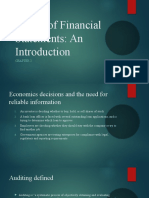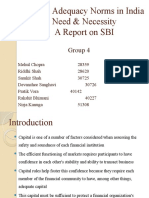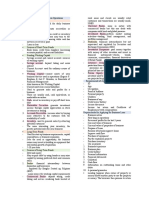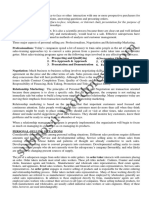Auditing Concepts and Standards: Understanding Audits
Auditing Concepts and Standards: Understanding Audits
Uploaded by
Shamsah MaqboolCopyright:
Available Formats
Auditing Concepts and Standards: Understanding Audits
Auditing Concepts and Standards: Understanding Audits
Uploaded by
Shamsah MaqboolOriginal Title
Copyright
Available Formats
Share this document
Did you find this document useful?
Is this content inappropriate?
Copyright:
Available Formats
Auditing Concepts and Standards: Understanding Audits
Auditing Concepts and Standards: Understanding Audits
Uploaded by
Shamsah MaqboolCopyright:
Available Formats
Auditing Concepts and Standards
BY PATRICK J. COSTELLO, CPPM, CF, SHAMROCK CHAPTER
exchanges of information, which often make the proper
T
his is the first in a series of articles addressing
Auditing in general and Auditing as a function of recording of transactions and allocations of costs difficult
Property Management. The second article will to track.
address the System Analysis process. The third article will The physical remoteness of the system increases the
look at the role professional organizations play in the field likelihood both of intentional or unintentional error and
of auditing. of demand for an independent party to examine the
records.
Understanding Audits Bias and motives of the provider create a demand for
This article offers the reader an opportunity to under- an independent party to lend credibility to the company’s
stand audits and system analysis processes. In a broad con- financial or property system statements. For example,
text, audits and system analysis are “kissing cousins” – sys- management may be more optimistic about the status of
tem analysis being a subset of audits that relates to govern- the property system than the Government. The optimism
ment contracting, compliance, and property issues. The may be based on accurate or inaccurate statements of the
general category of audits covers a broad range of audit property department. The property department may have
types, most of which relate to financial issues (e.g., real a vested interest in presenting an optimistic picture of the
estate, financial portfolio, tax-related audits, or accounting system.
practice business audits). Audits are complex processes that Consequences associated with the reliability of infor-
are defined by the relationship of the auditor to the author- mation are cause for verification when the information is
ity requesting the audit and the entity being audited. used for costly business decisions, such as buy-outs, new
Today we see the discipline of auditing under fire contracts, stock evaluation, market pricing, etc.
because some major auditing and consulting firms have To understand the auditing process, you should
shown themselves lacking in compliance with industry- become familiar with the definitions that are important to
established ethics codes of conduct. The media is ripe with auditing.1
news describing the conflict generated by the Definition of Auditing: A systematic process of (1)
consultants/auditors when they ignored the principles of objectively obtaining and evaluating evidence regarding
their profession and advised clients to misrepresent them- assertions about economic actions and events to ascertain
selves to the public. They created an inter-dependence the degree of correspondence between those assertions and
between their customers and their firms that enriched both established criteria and (2) communicating the results to
entities at the expense of the employees and stockholders. interested users.
Auditors are required, by the nature of their profession, to Systematic Process: As a systematic process, auditing is
render opinions (attestations) based upon valid evidence a logical, purposeful, structured approach to decision-mak-
relating to the condition of their customers’ accounting ing; it is not an unplanned, haphazard process.
practices. The auditor is liable for the accuracy of the opin- Objectively Obtaining and Evaluating Evidence:
ion rendered. This liability is a constant reminder of the Auditing involves the collection of evidence. Evidence rep-
extensive responsibilities entrusted to a person identified as resents the information collected by the auditor that will
an auditor. Responsibilities are not to be taken lightly by affect the auditor’s decision process. Although evidence
people who conduct audits or desire to become auditors. A itself may be more or less conclusive in nature, the process
plaintiff may bring suit against an auditor under common, of collecting and evaluating evidence should be objective.
statutory, or both common and statutory law.1 Assertions about Economic Actions and Events:
Auditing is a serious discipline. Auditors must be the Assertions are related to the financial statements of the
most experienced, knowledgeable, professionally qualified organization being audited. The auditor is given informa-
individuals in a discipline. National Property Management tion and statements from the auditee. These statements
Association represents the greatest potential for finding represent the auditee’s assertions about actions and events
individuals uniquely qualified to be auditors in the disci- and include not only the statements themselves but also
pline of Personal Property (Asset) Management. the accounting system and process. (This statement looks,
at first glance, to relate only to economic issues and finan-
The Role of Auditing: cial statements. However, if you understand that property
The demand for auditing is a result is in fact a function of economic values and that financial
statements include statements of assets and inventories,
of four underlying factors:
you can see where property issues fit.)
The complexity of the system refers to the activity in an
The Degree of Correspondence between Assertions
institution or business, along with the interaction of the
and Established Criteria: Correspondence here means the
12 NPMA Volume 15, Issue 6 – 2003
comparison of the assertions of the audi- through inspection, observation,
tee to the established criteria. The estab- inquiries, and confirmation to afford a
lished criteria may include, but are not reasonable basis for an opinion regard-
limited to, the following sources: Gener- ing the statement under consideration.
ally Accepted Accounting Practices Internal Control (SAS No. 1, The
(GAAP), Federal Acquisition Regula- Auditor’s Study and Evaluation of
tions (FAR), State or Municipal Regula- Internal Control): Internal controls
tions, and Corporate Policies and Proce- consist of the plan of an organization
dures. and all of the coordinate methods and
Communicating Results to Inter- measures adopted within a business to
ested Users: The communication of the safeguard its assets, check the accuracy
auditor’s assurance or information is and reliability of its accounting data,
referred to as attestation, or the attest function. Attestation promote operational efficiency, and encourage adherence to
is a communicated statement of opinion (judgment) based the prescribed managerial policies. Internal controls repre-
upon convincing evidence by an independent, competent, sent the means by which a company processes its account-
authoritative person concerning the degree of correspon- ing transactions so that reliable financial information can be
dence in all material respects of accounting information generated and safeguards its assets.2
communicated by an entity with established criteria. Sufficient Competent Evidential Matter: Competent
matter demands that the evidence is valid and relevant.2
Professional Standards An auditor must exercise professional judgement in deter-
Auditing standards represent a measure of the quality of mining the relevance of specific pieces of evidence and the
audit work performed. They are broad conceptual guide- objectivity, timeliness, and relationship to conclusions as to
lines that serve as a model for all auditors and should the overall fairness of the statements drawn from the audit.
remain relatively stable over time.
Generally Accepted Auditing Standards (GAAS) are Standards of Reporting
standards published by the American Institute of Certified The report shall either contain an expression of opinion
Public Accountants (AICPA). The Auditing Standards regarding the financial statements, taken as a whole, or an
Board issues pronouncements entitled Statements of assertion to the effect that an opinion cannot be expressed.
Auditing Standards (SASs). When an opinion cannot be expressed, the reasons should
Auditing procedures, on the other hand, represent spe- be stated.
cific audit tasks to be performed. For example, to comply In all cases the report should contain a clear-cut indica-
with an auditing standard that requires audits to be prop- tion of the character of the auditor’s examination and the
erly planned, the auditor may perform the specific audit degree of responsibility he/she is taking.
procedure of holding a preliminary planning meeting with
client personnel. Suggested Code of Professional
Ethics (Taken in part from the AICPA Code of Ethics)1
General Standards Independence – Integrity – Objectivity: An auditor
The examination is to be performed by a person or per- should maintain integrity and objectivity and, when
son having adequate technical training and proficiency as engaged in the practice of property management, be inde-
an auditor. In all matters relating to the assignment, the pendent of those served.
auditor must maintain an independent mental attitude. General and technical standards: An auditor should
(Public Confidence)2 observe the profession’s general and technical standards
Due professional care is to be exercised in the perfor- and strive continually to improve competence and quality
mance of the examination and the preparation of the of services.
report. (Prudent Practitioner)2 Responsibilities to clients: An auditor should be fair
and candid with clients and serve them to the best of the
Standards of Fieldwork auditor’s ability, with professional concern for their best
Audits must be adequately planned and properly super- interests, consistent with the auditor’s responsibilities to
vised. Proper planning must be undertaken to insure effec- the public.
tive results. Planning must include the requirements for Responsibilities to colleagues: An auditor should con-
personnel and the logistics to support the personnel under- duct himself/herself in a manner that will promote cooper-
taking audits. Existing internal controls must be studied ation and good relations among the members of the pro-
and evaluated to define the tests to be applied to the sub- fession.
ject audit. Other responsibilities and practices: An auditor
Sufficient competent evidential matter is to be obtained should conduct himself/herself in a manner that will
Volume 15, Issue 6 – 2003 NPMA 13
enhance the stature of the profession and its ability to serve Policies and Procedures
the public. Operational Audits
The Auditor’s Legal Liability: We live in a litigious Effectiveness
society. The auditor today can reasonably expect his or her Efficiency
every action—regardless of how right or wrong it may be –
to be questioned in a court of law and possibly to result in Why do we need audits?
substantial damages being awarded. Discovery: A Discovery Audit is conducted to affirm
Privity of Contract is a relationship between two or or disaffirm a suspected problem.
more parties that creates a contractual duty. In an auditing Investigative Reasons: Investigative Audits are con-
context, the auditor and client have a privity or contractual ducted to determine the facts when it has already been
relationship that is usually established by a contract called ascertained that a problem exists and the answers to ques-
an engagement letter. Usually, however, third parties such tions are needed.
as investors or creditors are not parties to the contract and Risk Assessment: A Risk Assessment Audit is conduct-
are said to have a nonprivity relationship. ed to determine the risk and the magnitude of the risk.
Due professional care is the performance of, and Validation: A Validation Audit is conducted to conclu-
reporting on, a professional engagement with the degree of sively verify a finding.
care, competence, learning, and experience commonly pos-
sessed by other members of the auditing profession and The Relationship between Audits
required by professional standards.
Negligence is the failure of the auditor to perform or and System Analyses
report on an engagement with the due professional care Audits have a broader financial scope than System
and competence of a prudent auditor. The auditor is negli- Analyses in that most audits cover a spectrum of financial
gent if he or she fails to do what the ordinary, reasonable, functions that tie to corporate financial reporting rather
prudent auditor would do, or does what the prudent audi- than a focus on property management. The underlying
tor would not do. Sometimes negligence may be referred issue with audits and system analyses is the actual loss or
to as simple or ordinary. Simple negligence, ordinary negli- the risk for loss (money) associated with the system of con-
gence, and negligence are synonymous. trols established at the organization being audited.
Gross negligence (a.k.a. recklessness or constructive System Analyses are a form of Compliance Audits
fraud) is a serious occurrence of negligence tantamount to focusing on contract materials, capital type assets, and real
a flagrant or a reckless departure from the standard of due estate that are part of the contract. A financial impact is
care. These terms are frequently used interchangeably and associated with System Analyses. All of the previous discus-
are equivalent to sloppy auditing or lack of a reasonable sion of Audits is applicable to System Analyses. A System
basis for a belief. A plaintiff in establishing gross negligence Analysis is an audit of the organizational property control
must prove each of the following assertions: system.
● The auditor made a representation about a material fact
Summary
with lack of reasonable support.
I have addressed many of the basics of auditing in this
● The purpose of the representation was to induce reliance
article; however, all of us must understand that this is only
by another (for example, a client or a third-party user of a glimpse of a vast discipline. ◆
the financial statements).
● The representation was relied upon by the client or a Notes: 1 Auditing, Dan M Guy/C Wayne Alderman, Harcourt Brace
Jovanovich, 1987
third party. 2 Statement on Audit Standards (SAS) No 1, Generally Accepted
● The reliance caused damages to the client or third party. Auditing Standards (GAAS)
Fraud occurs when an auditor issues an opinion on the
financial statements knowing that the financial statements PATRICK J. COSTELLO, CPPM, CF, lives in Nashville, Georgia. He
has been a consultant for the last five years. Pat retired from the U.S.
or the audit report thereon are false. Fraud differs from Army in 1985 as a LTC after serving 31 years. He worked as a Property
gross negligence in that the auditor does not merely lack Manager with several Aerospace Corporations for thirteen years until
reasonable support for belief, but has both knowledge of he retired in 1997. Pat directed inspection teams during his military
career that audited the logistics and maintenance of military units in
the falsity and intent to deceive a client or third party. the United States and overseas. He has participated in the conduct of
hundreds of inspections and audits, external and internal, in his forty-
six years as a logistician. Pat developed and teaches a course in
Types of Audits (not an exclusive listing) Auditing/System Analysis for NPMA. He has served on the national
Audits of Financial Statements level of the NPMA as Director of Professional Development for more
Compliance Audits than six years, as Secretary of the Eastern Region, and as President of
the Nutmeg Chapter, formerly the Pioneer Valley Chapter. Pat has
Contract published numerous articles on property topics over the past seven-
Federal and State law teen years.
14 NPMA Volume 15, Issue 6 – 2003
You might also like
- A Guide to Effective Internal Management System Audits: Implementing internal audits as a risk management toolFrom EverandA Guide to Effective Internal Management System Audits: Implementing internal audits as a risk management toolRating: 3 out of 5 stars3/5 (5)
- Chapter 2 & 4 AuditingDocument23 pagesChapter 2 & 4 AuditingAimae Inot MalinaoNo ratings yet
- Chapter I - Overview of AuditDocument16 pagesChapter I - Overview of AuditMarj Manlagnit100% (1)
- Lecture Notes: Auditing Theory AT.0106-Understanding The Entity and Its Environment MAY 2020Document7 pagesLecture Notes: Auditing Theory AT.0106-Understanding The Entity and Its Environment MAY 2020MaeNo ratings yet
- Introduction To Financial Statements AuditDocument8 pagesIntroduction To Financial Statements AuditDemafilasan, Khyro Paul G.No ratings yet
- Chapter 2 Audit of Financial StatementsDocument6 pagesChapter 2 Audit of Financial Statementsjhell dela cruzNo ratings yet
- CHAPTER 1 - Overview of AuditingDocument8 pagesCHAPTER 1 - Overview of AuditingkapaymichelleNo ratings yet
- Lecture Notes: Auditing Theory AT.0104-Introduction To Audit of Financial StatementsDocument8 pagesLecture Notes: Auditing Theory AT.0104-Introduction To Audit of Financial StatementsMaeNo ratings yet
- Presentation 2Document35 pagesPresentation 2Ma. Elene MagdaraogNo ratings yet
- Case 2Document21 pagesCase 2Nathalie PadillaNo ratings yet
- 1) Lec 1 - The Auditing Assurance EnvironmentDocument15 pages1) Lec 1 - The Auditing Assurance Environmentcats singhNo ratings yet
- CH 1 Advanced Auditing.Document47 pagesCH 1 Advanced Auditing.Ermiyas KebedeNo ratings yet
- Chapter 1Document9 pagesChapter 1Nicale JeenNo ratings yet
- pdfDocument8 pagespdfdexter daysoNo ratings yet
- Chapter 7 AuditingDocument25 pagesChapter 7 AuditingMisshtaCNo ratings yet
- 04 IS Audit ProcessDocument70 pages04 IS Audit Processnaz bNo ratings yet
- L3 Audit PlanningDocument7 pagesL3 Audit PlanningJun Guerzon PaneloNo ratings yet
- taxation-test-26-ch-13-Solution-1722595185Document10 pagestaxation-test-26-ch-13-Solution-1722595185PallaviNo ratings yet
- Master of Business Administration - MBA Semester 3Document16 pagesMaster of Business Administration - MBA Semester 3Mihir DesaiNo ratings yet
- Definition and Objective of AuditDocument7 pagesDefinition and Objective of AuditZednem JhenggNo ratings yet
- Importance of An External AuditDocument3 pagesImportance of An External AuditmirakenthNo ratings yet
- Fundamentals of Auditing and Assurance Services OverviewDocument8 pagesFundamentals of Auditing and Assurance Services OverviewSkye LeeNo ratings yet
- Chapter 1Document18 pagesChapter 1temedebereNo ratings yet
- Chapter-One: 1 Introduction - An Overview of Auditing 1.1 Historical Background of Auditing PracticesDocument76 pagesChapter-One: 1 Introduction - An Overview of Auditing 1.1 Historical Background of Auditing PracticesYohannes TesfayeNo ratings yet
- Understanding The Entity and Its EnvironmentDocument4 pagesUnderstanding The Entity and Its EnvironmentIrish SanchezNo ratings yet
- C9ay1 HsijbDocument15 pagesC9ay1 HsijbEyob FirstNo ratings yet
- 10.1007@978 3 319 90521 11Document14 pages10.1007@978 3 319 90521 11Ibtissam EljedaouyNo ratings yet
- (AAP) CH2 Fundamentals of AuditingDocument7 pages(AAP) CH2 Fundamentals of AuditingkshearthhNo ratings yet
- Mid-Term Exam - IA - Ashilla Nadiya Amany - 2002030013Document7 pagesMid-Term Exam - IA - Ashilla Nadiya Amany - 2002030013Ashilla Nadya AmanyNo ratings yet
- A&a L6 EditedDocument6 pagesA&a L6 EditedKimosop Isaac KipngetichNo ratings yet
- Arens Auditing16e Sm 25Document17 pagesArens Auditing16e Sm 25JosartNo ratings yet
- Ssadi NotesDocument6 pagesSsadi NotesYnzon, Elaiza MarieNo ratings yet
- GL OsarioDocument10 pagesGL Osariojuan david peñaNo ratings yet
- Chapter 1 NotesDocument8 pagesChapter 1 NotesmatthewNo ratings yet
- Module 1 - Introduction of Assurance and Auditing Services.Document27 pagesModule 1 - Introduction of Assurance and Auditing Services.KzeNo ratings yet
- The Elements of Auditing (Part 01)Document44 pagesThe Elements of Auditing (Part 01)mahedi.hasan.fcaNo ratings yet
- Internal Audit: Defining, Objectives, Functions and Stages: Studies in Business and EconomicsDocument9 pagesInternal Audit: Defining, Objectives, Functions and Stages: Studies in Business and Economicsmax channelNo ratings yet
- AuditingDocument14 pagesAuditingHayathi FaraNo ratings yet
- Chapter 1 An Overview of AuditingDocument11 pagesChapter 1 An Overview of Auditingmt619405No ratings yet
- 7.0 Topic 7 Public Sector Auditing 7.1 S PDFDocument17 pages7.0 Topic 7 Public Sector Auditing 7.1 S PDFhezronNo ratings yet
- c1 Fundamentals of Assurance ServicesDocument15 pagesc1 Fundamentals of Assurance ServicesEpfie SanchesNo ratings yet
- Auditing Theory Lecture NotesDocument26 pagesAuditing Theory Lecture NoteskæsiiiNo ratings yet
- Lesson 1-3Document86 pagesLesson 1-3eiraNo ratings yet
- ACCA - Audit Evidence and The Objectives of An AuditDocument14 pagesACCA - Audit Evidence and The Objectives of An AuditQorry NittyNo ratings yet
- At 02Document5 pagesAt 02Mitch PacienteNo ratings yet
- Auditing I Chapter OneDocument7 pagesAuditing I Chapter OneBam FbhNo ratings yet
- Chapter 02 Overview of AuditingDocument26 pagesChapter 02 Overview of AuditingRichard de LeonNo ratings yet
- Lecture Notes: Auditing Theory AT.0107-Understanding The Entity's Internal Control MAY 2020Document6 pagesLecture Notes: Auditing Theory AT.0107-Understanding The Entity's Internal Control MAY 2020MaeNo ratings yet
- Auditing and Assurance PrinciplesDocument10 pagesAuditing and Assurance PrinciplesJoannah maeNo ratings yet
- Assignment Set-1: Q.1 Discuss Is Auditing Is A Luxury AnsDocument14 pagesAssignment Set-1: Q.1 Discuss Is Auditing Is A Luxury Ansvaishnavbipin5555No ratings yet
- Chapter 1Document3 pagesChapter 1anjiemae eltagonNo ratings yet
- Almednralejo Chap7 DiscussionDocument10 pagesAlmednralejo Chap7 DiscussionRhywen Fronda GilleNo ratings yet
- Advanced Auditing: Chapter One General Understanding of AuditingDocument44 pagesAdvanced Auditing: Chapter One General Understanding of AuditingmirogNo ratings yet
- AuditDocument19 pagesAuditRuzel DayluboNo ratings yet
- Auditing & Assurance Principles-Lesson 1Document12 pagesAuditing & Assurance Principles-Lesson 1Joe P PokaranNo ratings yet
- Assurance EngagementDocument6 pagesAssurance EngagementEmmaNo ratings yet
- Chapter 1 AudcisDocument6 pagesChapter 1 AudcisJaylin DizonNo ratings yet
- Stakeholders Material Legal PersonDocument3 pagesStakeholders Material Legal Personansari naseem ahmadNo ratings yet
- Audit Risk Alert: General Accounting and Auditing Developments, 2017/18From EverandAudit Risk Alert: General Accounting and Auditing Developments, 2017/18No ratings yet
- Mercy Marimo Thesis - Survival Analysis - 28.03. 2015 - v1Document213 pagesMercy Marimo Thesis - Survival Analysis - 28.03. 2015 - v1douglasNo ratings yet
- Computer FraudDocument19 pagesComputer FraudEunicel BalaneNo ratings yet
- Narrative PhilhealthDocument16 pagesNarrative PhilhealthJovanna MataNo ratings yet
- Lesson 1 Introduction To EntrepreneurshipDocument46 pagesLesson 1 Introduction To Entrepreneurshipsja254677No ratings yet
- ALL - IMP वाक्यप्रचार - मराठी व्याकरणDocument10 pagesALL - IMP वाक्यप्रचार - मराठी व्याकरणNaukri CornerNo ratings yet
- Sample Business Plan For A Microfinance CompanyDocument5 pagesSample Business Plan For A Microfinance Companyprtjaa1aNo ratings yet
- Notes On Law of Corporate FinanceDocument81 pagesNotes On Law of Corporate FinanceC AbhijithNo ratings yet
- The Aim and Scope of The OHS Act 1Document4 pagesThe Aim and Scope of The OHS Act 1ChristineNo ratings yet
- Two Cables. One Connector. It All Fits. Who Says You Can't Have It All?Document2 pagesTwo Cables. One Connector. It All Fits. Who Says You Can't Have It All?Renzzo Gomez ReatigaNo ratings yet
- Capital Adequacy Norms in India Need & Necessity A Report On SBIDocument41 pagesCapital Adequacy Norms in India Need & Necessity A Report On SBIPratikVoraNo ratings yet
- AutomatedDocument13 pagesAutomatedAkira BergañoNo ratings yet
- Screenshot 2024-04-15 at 2.24.55 AMDocument6 pagesScreenshot 2024-04-15 at 2.24.55 AMpassionatebhavnaNo ratings yet
- Final Exam - OpemgtDocument4 pagesFinal Exam - OpemgtJpoy RiveraNo ratings yet
- CM Presentation 30.01.22 v1Document49 pagesCM Presentation 30.01.22 v1Vikas RajputNo ratings yet
- Book Summary Start With WhyDocument6 pagesBook Summary Start With WhyHan Hisyam Pratama100% (2)
- Cambridge English Exam Booster For Advanced With Answer Key 48 51Document4 pagesCambridge English Exam Booster For Advanced With Answer Key 48 51argotecNo ratings yet
- Ktra T V NG Lesson 5 OfficialDocument6 pagesKtra T V NG Lesson 5 Officialhoanghongnhungsl123No ratings yet
- A Study On Customer Profiling of Shriram Life Insurance CustomersDocument6 pagesA Study On Customer Profiling of Shriram Life Insurance Customersprashant.sharma2467No ratings yet
- Cleaning Company ProfileDocument1 pageCleaning Company Profilebatousai1900No ratings yet
- Tushman & OReilly 1996 Ambidextrous OrganizationsDocument23 pagesTushman & OReilly 1996 Ambidextrous OrganizationsMarcello MNo ratings yet
- FAR 2 REVIEWER Other SourceDocument120 pagesFAR 2 REVIEWER Other SourceAirish GeronimoNo ratings yet
- Crypto One-PagerDocument1 pageCrypto One-PagerkoperasisuksesabadiNo ratings yet
- Salasar Sales 2023Document20 pagesSalasar Sales 2023tryabhi1234No ratings yet
- FRC Best Practice ProcessDocument43 pagesFRC Best Practice ProcessbilalghaznaviNo ratings yet
- Business Finance Final TermDocument3 pagesBusiness Finance Final TermClarice TorresNo ratings yet
- Personal Selling 1Document13 pagesPersonal Selling 1Sunil SewakNo ratings yet
- Anne Mulcahy - Leading Xerox Through The Perfect StormDocument18 pagesAnne Mulcahy - Leading Xerox Through The Perfect Stormabhi.slch6853No ratings yet
- Social Media Importance On TourismDocument4 pagesSocial Media Importance On TourismArditÇekaNo ratings yet
- Wa0097 PDFDocument57 pagesWa0097 PDFPooja PhadatareNo ratings yet
- Proposal (Esport Day)Document6 pagesProposal (Esport Day)fizul18320No ratings yet

























































































